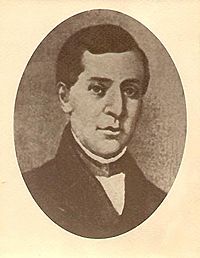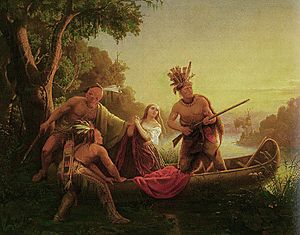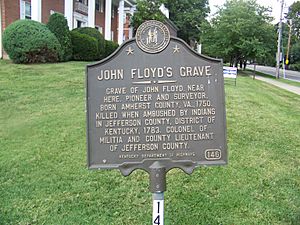John Floyd (pioneer) facts for kids
Quick facts for kids
John Floyd
|
|
|---|---|

Col. John Floyd
|
|
| Born | 1750 |
| Died | April 10, 1783 (aged 32–33) |
| Cause of death | Gunshot |
| Resting place | Breckinridge Cemetery St. Matthews, Kentucky |
James John Floyd (born 1750, died 1783) was an important early settler in Kentucky. He helped create the city of Louisville. In Kentucky, he was a Colonel in the Kentucky Militia. He worked with famous explorer George Rogers Clark. Later, he became one of Kentucky's first judges.
Contents
Life Story
Early Life in Virginia
James John Floyd was born in 1750 in Amherst County, Virginia. His parents were William and Abadiah (Davis) Floyd. Their family came from Wales. A family story says his mother was related to Opchanacanough, a leader of the Powhatan people. Another story says her brother was the grandfather of Jefferson Davis. The Floyd family had a farm in Virginia. They lived well, but young James wanted more chances in the western lands.
When he was 18, he married Matilda Burford. She was the daughter of the local sheriff. Sadly, Matilda died a year later when their daughter, Mourning Floyd, was born. In 1770, at age 20, James moved to Botetourt County, Virginia. He worked as a teacher and lived with Colonel William Preston. Preston was a very important person on the Virginia frontier. He was a surveyor for the western part of Virginia, which was called Fincastle County, Virginia then. This area reached all the way to the Mississippi River.
Floyd became Preston's assistant surveyor. He helped measure and map land. When he wasn't surveying, he worked as a deputy sheriff. Preston started getting requests from soldiers who fought in the French and Indian War. They wanted land in the west. In 1774, Floyd was chosen to lead a group of surveyors. Their job was to explore and map lands in what is now West Virginia and Kentucky.
Adventures in Kentucky
On April 7, 1774, Floyd and seven other surveyors headed for the Falls of the Ohio. They traveled along the Kanawha River and Ohio River. Floyd had already surveyed land for famous people like George Washington and Patrick Henry. In May, they reached Kentucky. They met Native Americans who had warnings from Fort Pitt. These warnings told white settlers to stay away because of Dunmore's War. Some of Floyd's group got scared and left. But the surveyors stayed. While mapping land, Floyd bought a large piece of land for himself. It was about 2,000 acres in what is now St. Matthews, Kentucky.
A war with the Shawnee seemed likely. So, Preston sent Daniel Boone and Michael Stoner to warn settlers to return to Virginia. Sadly, Native Americans attacked Floyd's group before the warning arrived. Two surveyors were killed. The rest of Floyd's group escaped down the Ohio and Mississippi Rivers to New Orleans. Floyd, alone, took the fastest way back to Virginia. He traveled across the land in just 16 days. He arrived near Clinch Mountain in Virginia. People there were getting ready for Dunmore's War. Floyd quickly gathered a group of fighters. He followed the main army but arrived a half-day late for the Battle of Point Pleasant on October 10, 1774. This battle ended Dunmore's War.
On April 21, 1775, Floyd got ready to go back to Kentucky. He went through the Cumberland Gap. Floyd took 32 men to Dix River in 1775 to set up a camp. This camp was only 20 miles from Boonesborough, Kentucky. Daniel Boone had founded Boonesborough on the Kentucky River. On May 23, 1775, Floyd went to Boonesborough. He was a delegate from the settlement of St. Asaph. They met to agree on laws for a new colony called Transylvania. This was the first time any government was formed west of the Allegheny Mountains. In the summer of 1776, Floyd lived in Boonesborough. He became the surveyor for Transylvania, working for its leader, Richard Henderson.
In July 1776, Floyd helped rescue Jemima Boone from four Shawnee and one Cherokee warrior. This event became a famous frontier story. The first night, they only traveled five miles because of a river crossing. The next day, they tracked the group for over 40 miles. They caught up to them while the warriors were making a campfire. News about the American Revolutionary War slowly reached Kentucky in late 1776.
A Privateer's Journey
In 1776, Virginia changed its laws, and Fincastle County was closed. So, John Floyd's job as a surveyor ended. In September 1776, Floyd left Boonesborough and went back to Virginia. He traveled to Williamsburg. There, he joined a group that owned a "privateer" ship. A privateer was a private ship allowed to attack enemy ships during wartime. Floyd agreed to serve on a ship called the Phoenix. Many important people were part of this group, including Robert Morris.
Floyd put a notice in a Williamsburg newspaper on December 26, 1776. He said he would be leaving Virginia for a few months. The Phoenix was supposed to sail from Yorktown, Virginia, to the West Indies. The trip was planned for three months. Floyd sailed out of Chesapeake Bay in early January 1777. The Phoenix arrived safely back in Boston in April 1777. But Floyd was not on board. He had been captured and taken to Forton Prison in England. In late October 1777, Floyd escaped from the prison. He made his way to Paris, France. On October 30, 1777, Arthur Lee, Benjamin Franklin, and Silas Deane helped him in Paris. They gave him money to return to Virginia.
While in Paris, Floyd bought new clothes, including a fancy scarlet coat for himself. He also bought beautiful shoe buckles for the woman he planned to marry. Floyd returned to Virginia from Paris in February 1778. After several months of getting better from his illnesses, Floyd married Jane Buchanan on November 2, 1778. Jane was a young woman who lived with Colonel Preston. Floyd lived on his father's farm for a year. Then, he met George Rogers Clark.
Back to Kentucky
Floyd returned to the Falls of the Ohio in October 1779. This time, he brought his new wife, Jane, and their son, William. His brothers Isham, Robert, and Charles, and sisters Jemima and Abadiah, also came with him to Kentucky. Floyd went back to the 2,000 acres of land he bought in 1774. He wanted to keep other settlers from taking his land. He became the first settler in Jefferson County, Kentucky who actually owned the land he lived on. They built a cabin in what is now Louisville. This was a temporary home for the women and children. Then, they built a settlement near Beargrass Creek. This settlement became known as Floyd's Station. Ten more families moved there, and they added a fort. Floyd became the leader of this area. He and his brothers took part in small local fights with Native Americans, led by George Rogers Clark.
In 1780, the Virginia government made Floyd one of seven leaders for Louisville. They had the power to plan and create the town. Later, George Rogers Clark convinced Governor Thomas Jefferson to make Floyd a Colonel in the Kentucky Militia in 1781. He also became a Justice of the Peace and surveyor for Jefferson County.
Floyd became the County Lieutenant of Jefferson County in 1781. This meant he was in charge of protecting the settlers in the county. Native Americans often raided the area, and many settlers were killed. Floyd wrote two letters to Thomas Jefferson, asking for help.
In September 1781, Floyd led 27 men on a mission to rescue people or bury the dead. This was after the Long Run Massacre the day before. When they reached the site, Floyd's group was attacked. Several of his men were killed. Floyd barely escaped. This event became known as Floyds Defeat.
Floyd also fought in the Battle of Blue Licks. After this battle, George Rogers Clark led raids on several Native American villages along the Great Miami River. Floyd joined these raids. On November 4, 1782, during Clark's raids, Colonel Floyd led 300 men toward a village. But they were discovered too early. The villagers escaped.
In 1783, Virginia organized the government of Kentucky. Floyd was chosen to be one of Kentucky's first two judges. In March of that year, he wrote to Preston. He told him that his brother-in-law, Billy Buchanan, had been killed by Native Americans. In the same letter, Floyd wrote that he dreamed he might meet the same fate. This dream came true. A month later, on April 8, 1783, Floyd was wounded by Native Americans. He was on his way to Bullitt's Lick. He was wearing the scarlet coat he had bought in Paris. He died from his injuries on April 10, 1783. His wife, Jane, kept the scarlet coat until 1812. She asked to be buried with it, and she was. Floyd is buried near Floyd's Station at Breckinridge Cemetery.
Legacy
Several places are named after John Floyd. Floyd County, Kentucky, is named for him. Floyd County, Indiana, is also said to be named after him. The Floyds Fork river is named after him. Where it meets the Salt River is near where he was fatally wounded. Floydsburg, Kentucky, a small community, is also named after Floyd. Floyd Street in Louisville, which runs through the University of Louisville, is also named after him.
See also
- Charles Floyd - Nephew
- Davis Floyd - Nephew
- John Floyd - Son and Governor of Virginia
- George Rogers Clark Floyd - Grandson
- John B. Floyd - Grandson and Governor of Virginia
- Floyds Fork
- Floyd's Station (Kentucky)



